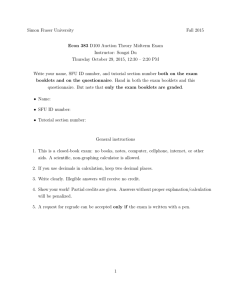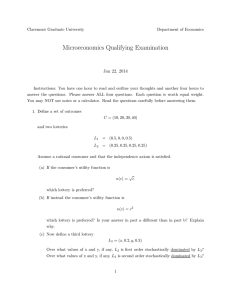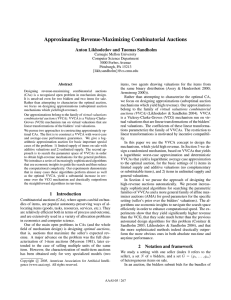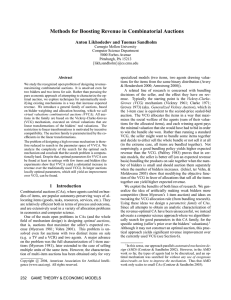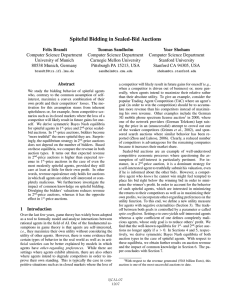Document 13578584
advertisement
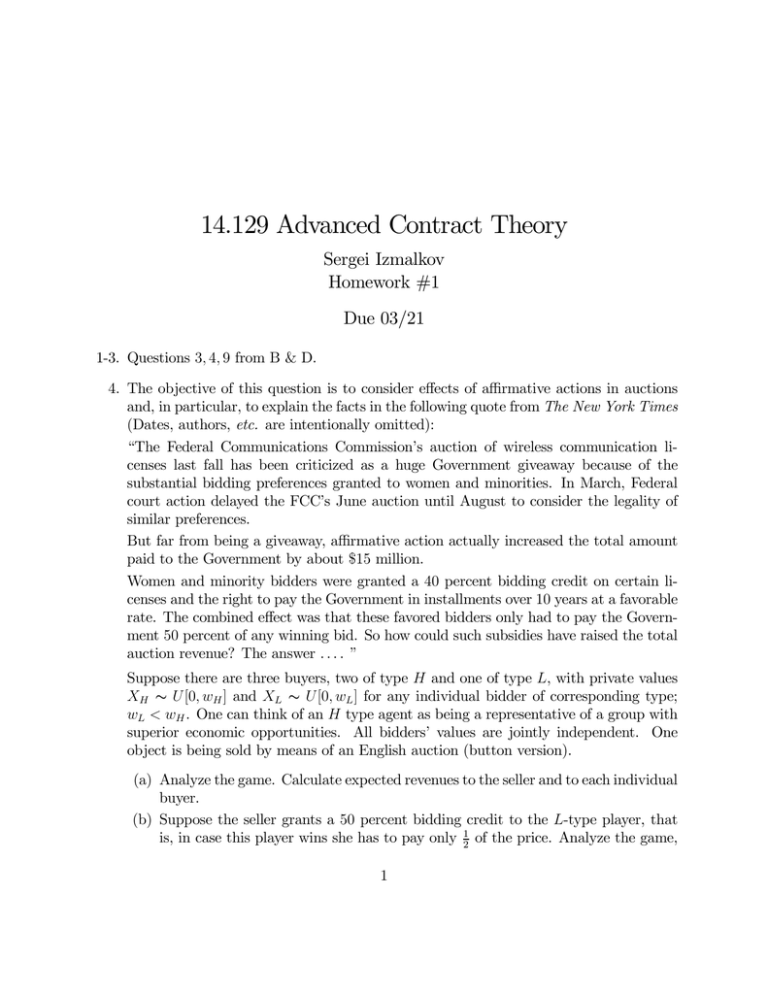
14.129 Advanced Contract Theory Sergei Izmalkov Homework #1 Due 03/21 1-3. Questions 3, 4, 9 from B & D. 4. The objective of this question is to consider effects of affirmative actions in auctions and, in particular, to explain the facts in the following quote from The New York Times (Dates, authors, etc. are intentionally omitted): “The Federal Communications Commission’s auction of wireless communication li censes last fall has been criticized as a huge Government giveaway because of the substantial bidding preferences granted to women and minorities. In March, Federal court action delayed the FCC’s June auction until August to consider the legality of similar preferences. But far from being a giveaway, affirmative action actually increased the total amount paid to the Government by about $15 million. Women and minority bidders were granted a 40 percent bidding credit on certain li censes and the right to pay the Government in installments over 10 years at a favorable rate. The combined effect was that these favored bidders only had to pay the Govern ment 50 percent of any winning bid. So how could such subsidies have raised the total auction revenue? The answer . . . . ” Suppose there are three buyers, two of type H and one of type L, with private values XH ∼ U [0, wH ] and XL ∼ U [0, wL ] for any individual bidder of corresponding type; wL < wH . One can think of an H type agent as being a representative of a group with superior economic opportunities. All bidders’ values are jointly independent. One object is being sold by means of an English auction (button version). (a) Analyze the game. Calculate expected revenues to the seller and to each individual buyer. (b) Suppose the seller grants a 50 percent bidding credit to the L-type player, that is, in case this player wins she has to pay only 12 of the price. Analyze the game, 1 calculate expected revenues. Compare with a), discuss. Can you provide an answer to the above quote? What is the intuitive reason for the revenue increase? (c) Calculate optimal mechanism for sale under the above conditions? Can you de scribe this mechanism as an auction? “As the White House searches to identify affirmative auction programs that work, the FCC’s success fostering diversity and reducing the deficit should count in favor of continuing this practice. But the court action on the legality of similar affirmative action preferences threatens to undo what may be — at least measured by its impact on the Treasury — one of the most successful affirmative auction programs.” (or successful legalization of the discriminatory practices by the Government?) 5. There are multiple homogenous objects for sale, M in total; N interested buyers (risk neutral). The bidders are ex ante symmetric, and valuations are independent across bidders. [Throughout the exercise you do not need to check or prove the existence of equilibria, assume, in particular, that a symmetric (monotone) equilibrium exists whenever you need it.] (a) Suppose each bidder has a unit demand, that is, V i (M) = V i (1) for any bidder i and quantity m = 1..M . Each V i is distributed according to F [0, w]. (iid) Calculate bidding strategies in the uniform price, discriminatory and Vickrey (all simultaneous) auctions. (b) Under same conditions as in (a) consider sequential (one unit at a time) firstprice and English auctions. Calculate symmetric equilibria there (you are not required to find all possible symmetric equilibria if multiple equilibria exist, but characterizing all of them would be a bonus). What can you say about pattern of prices from auction to auction? Do you have a Revenue Equivalence theorem that covers both simultaneous and sequential auction forms? Explain why you do or why you do not. (c) Suppose now you are selling M objects sequentially by means of English auctions. Each buyer may demand more than one object, marginal valuations, Vji of each buyer are non-increasing Pm (thei goods are substitutes). Total value of obtaining m i objects is V (m) = j=1 Vj . For simplicity, suppose that marginal valuations come from ordered in the descending order independent draws from a known distribution F [0, w]. Find a “plausible” equilibrium of this game. What you can say about pattern of prices? Do you have a revenue equivalence of this auction to, say, the Vickrey auction? 2


